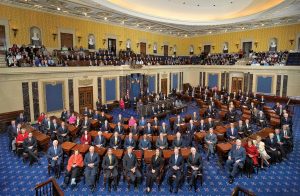3.5: The Undemocratic Senate
- Page ID
- 134543
“We should keep in mind that the original one-state, two-senators rule was written and ratified by property-owning white men, almost half of whom owned slaves…”
–Eric Orts (1)
The Senate as an Affront to Democratic Principles
Journalist and former congressional candidate Norman Solomon wrote that “today, the U.S. Senate is the most undemocratic elected body in the nation.” (2) Of course, the Senate was never designed to be a democratic body—remember that the Senate was initially chosen by state legislators rather than the people.
In 1913, the Seventeenth Amendment changed the Senate selection process by having the people directly elect senators. This action made senators more responsive to the democratic will within their respective states, but the basic problem is structural and has to do with how senators are apportioned. Senate seats are apportioned equally between the states, with each state getting two senators regardless of population. This enormously distorts the democratic principle of one-man, one-vote. Consider that the 7 million residents of Alaska, Delaware, Montana, North Dakota, Rhode Island, South Dakota, Vermont, and Wyoming elect sixteen senators; meanwhile, the 147 million Americans living in California, Florida, Illinois, New York, Ohio, Pennsylvania, and Texas elect only fourteen senators.

In the 1964 case Wesberry v. Sanders, the Supreme Court ruled that unequal House election districts were an unconstitutional violation of the “one-man, one-vote” standard for legislative districts. House districts are sized accordingly and are roughly equal in population, with the important caveat that each state gets at least one representative. (4) Unfortunately, this logic cannot penetrate the U.S. Senate because the Constitution’s language enshrines that body’s undemocratic structure. From the strictly mathematical view, any constitutional amendment to remedy the situation would have to garner a two-thirds vote in the House of Representatives and the Senate itself. Also, Article V of the Constitution stipulates that “no State, without its Consent, shall be deprived of its equal Suffrage in the Senate.” Thus, fixing the senators’ apportionment would also require the small states to agree to give up the disproportionate power they now have.
The Senate’s unrepresentative structure—being based on states rather than on population—has real-world political consequences. For one thing, the senators from the twenty-six smallest states hold the most Senate seats even though they represent only 17 percent of the U.S. population. They can refuse to pass legislation desired by the majority of the population, the House, and the president. Small states and rural interests gain disproportionate power in this scheme.
The Senate apportionment problem is compounded by the filibuster. Currently, it only takes forty-one senators to defeat a cloture motion and prevent a bill from being voted on. If the forty-one senators sustaining a filibuster happened to come from the least populous states, it would mean that the senators representing less than 12 percent of the population are inhibiting legislation that the population’s vast majority wants. In response to Senator Rand Paul’s thirteen-hour filibuster to protest the Obama administration’s drone attacks, Adam Winkler notes that the filibuster is not mentioned in the Constitution and it was not even used until 1841. The Constitution requires only a simple majority vote to pass legislation, and it carefully spells out the few situations that require a different rule—for example, a two-thirds Senate vote to remove someone who has been impeached by the House or a two-thirds Senate vote to support a treaty. (6)
Possible Solutions to the Undemocratic Senate Problem
People have often entertained possible ways to fix the problem.
- Leave the apportionment system alone but break up large states so that each new state would have its own two senators. California, for instance, could be broken up into six or eight states. (7)
- Simply abolish the Senate by constitutional amendment. (8)
- Expand the Senate to 110 seats, give one seat to each state, and then give additional seats to states according to population. (The move would only require legislation rather than a Constitutional amendment. Why? Because in cases like Reynolds v Sims (1964) and even Bush v. Gore (2000), the Supreme Court has already firmly established the constitutional principle of one-man-one-vote, and the Congress is already empowered through amendments like the Fourteenth, Fifteenth, and the Nineteenth to uphold American citizens’ privileges and immunities—of which voting is one. (9))
What if . . . ?
What would you do about this undemocratic institution sitting firmly in the middle of our republic? Would you vote to support splitting up large states? What if you were a resident of one of the less populous states? Would you vote to abolish the Senate altogether? What does it say about our democracy when we seem so unable to address such an obviously undemocratic anachronism?
References
- Eric W. Orts, “The Path to Give California 12 Senators and Vermont Just One,” The Atlantic. January 12, 2019.
- Norman Solomon, “All Eyes are on the Senate—But What is It?” Fairness and Accuracy in Reporting. December 30, 1998.
- George Packer, “The Empty Chamber,” The New Yorker. August 9, 2010.
- Reynolds v. Sims (1964).
- Richard N. Rosenfeld, “What Democracy? The Case for Abolishing the United States Senate,” Harper’s Magazine. May, 2004.
- Adam Winkler, “Is the Filibuster Unconstitutional?” The New Republic. March 7, 2013.
- Burt Neuborne, “Divide States to Democratize the Senate,” Wall Street Journal. November 19, 2018. David Faris, It’s Time to Fight Dirty. New York: Melville House Publishing, 2018.
- John D. Dingell, “I Served in the Congress Longer Than Anyone. Here’s How to Fix It,” The Atlantic. December 4, 2018.
- Eric W. Orts, “The Path to Give California 12 Senators and Vermont Just One,” The Atlantic. January 12, 2019.
Media Attributions
- Senate © United States Senate is licensed under a Public Domain license

